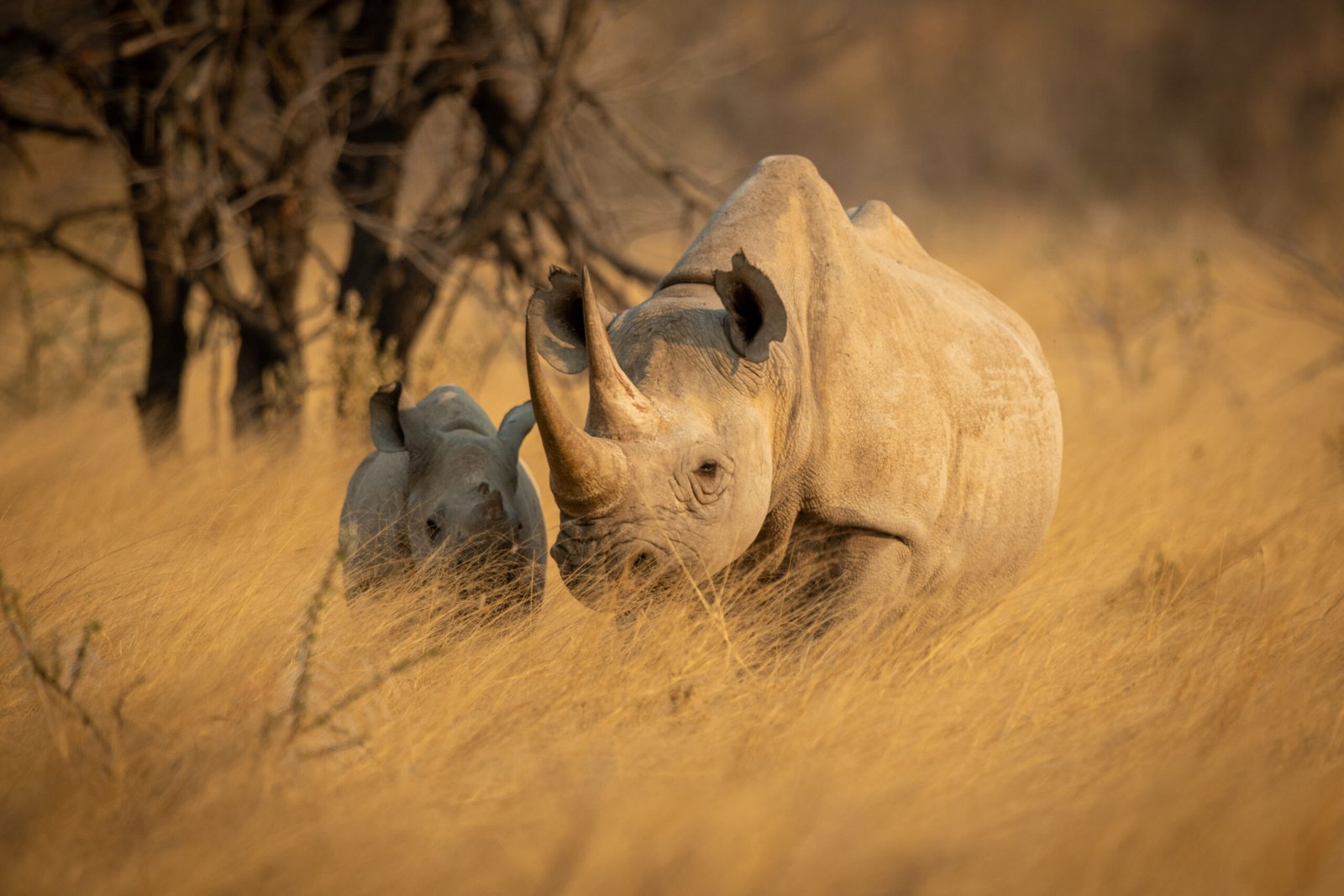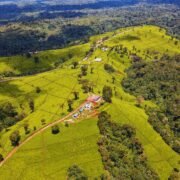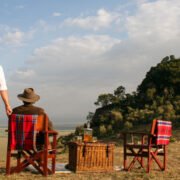
The Ultimate Guide to Kenya’s Big Five Safari – Where and When to Spot Them
Introduction to Kenya’s Big Five
The term “Big Five” is a designation given to five of the most iconic and sought-after animals in the African wildlife landscape: the lion, leopard, rhinoceros, elephant, and Cape buffalo. Originating from the hunting era, the Big Five now represents a key attraction in Kenya’s thriving wildlife tourism industry. These majestic creatures encapsulate the allure of safaris, drawing thousands of visitors from around the globe seeking an unforgettable experience in their natural habitat.
In Kenya, where to see the Big Five in their natural environment is a frequent inquiry among travelers. Each species of the Big Five has its unique habitat and behaviors that enhance the excitement of safari tours. The Maasai Mara, known for its spectacular big five sightings, provides an unparalleled opportunity to witness these animals within the stunning backdrop of the African savannah. Additionally, Amboseli National Park offers remarkable close-up views of elephants against the iconic Kilimanjaro, while Tsavo National Park provides opportunities for witnessing rhinos and buffalo in less crowded settings.
The significance of these animals extends beyond their size and status; they represent the rich ecological diversity of Kenya. This diversity encourages conservation efforts and contributes to the local communities’ economies through eco-tourism. With various Kenya big five safari packages available, travelers can select experiences tailored to their desires, whether they prefer the excitement of a jeep safari or the intimacy of a guided walking tour.
Best time to see the Big Five in Kenya spans initial months from June to October, coinciding with the dry season when wildlife congregates around water sources. Accordingly, many safari tours from Nairobi are organized during this peak season. Ultimately, a big five safari in Kenya is not merely about spotting these magnificent animals; it is an immersive experience that connects travelers with nature and fosters a deeper appreciation for wildlife conservation.
Best National Parks and Reserves to Spot the Big Five
Kenya is renowned for its diverse ecosystems and rich wildlife, making it a premier destination for those seeking the iconic Big Five: lions, leopards, elephants, rhinoceros, and Cape buffalo. The following national parks and reserves are among the best locations to experience thrilling Big Five safari adventures.
The Maasai Mara National Reserve is arguably the most famous spot for Big Five sightings in Kenya. This expansive reserve is known for its vast savannahs and is a crucial part of the Great Migration ecosystem, where numerous animals traverse the plains each year. Travelers are often treated to spectacular views of all five species, especially during the migration season when wildlife concentrations peak. The Mara’s diverse landscapes provide perfect habitats for various species, ensuring that visitors have excellent opportunities to capture memorable moments.
Amboseli National Park, located at the foot of Mount Kilimanjaro, is another prime location to encounter the Big Five. Elephants are particularly abundant here, allowing for remarkable close encounters with these gentle giants. The distinct backdrop of the mountain combined with unique ecosystems such as swamps and woodlands creates a captivating environment for wildlife observation. Travelers can enjoy Amboseli big five safari tours, which often include not only observations of the Big Five but also spectacular bird watching opportunities.
Tsavo National Park, one of Kenya’s largest and oldest parks, is well-known for its dramatic scenery and the diversity of wildlife. Visitors can embark on Tsavo big five tours while exploring its rich landscapes, which include savannahs, hills, and volcanic mountains. The park is particularly famous for its red elephants, which wallow in the red earth, creating iconic images for safari enthusiasts. Furthermore, Lake Nakuru National Park, while primarily famous for its flamingos and beautiful landscapes, also presents opportunities to spot the Big Five in a more compact nature reserve setting.
Each of these locations offers unique environments that enhance the chances of encountering the Big Five in Kenya. Whether through organized Kenya big five safari packages or self-guided experiences, travelers are bound to have an unforgettable encounter with Africa’s majestic wildlife.
The Best Time of Year for a Big Five Safari
When planning a big five safari in Kenya, timing is crucial for optimal wildlife sightings. The term “Big Five” refers to the lion, leopard, rhinoceros, elephant, and Cape buffalo, and understanding their seasonal behavior can greatly enhance safari experiences. The best time to see the Big Five in Kenya is generally during the dry season, which runs from June to October. During this period, animals gather around water sources, making them easier to spot.
The Maasai Mara is particularly famous for its big five sightings during this time, drawing numerous tourists eager to witness wildlife in their natural habitat. The dry conditions lead to reduced vegetation, allowing for more extensive visibility across the savannah. Moreover, July through September coincides with the Great Migration, where millions of wildebeest traverse the plains, attracting predators and offering fantastic opportunities for photographers and wildlife enthusiasts alike.
However, the wet season from November to May also presents unique opportunities. The landscape becomes lush and green, providing excellent conditions for breeding and nurturing young animals. While tracking the Big Five in Kenya during the wet months can be more challenging due to dense foliage, many travelers appreciate the vibrancy of the wildlife and the variety of species visible, especially in parks like Amboseli and Tsavo.
Particular months to consider include January and February, when many animals give birth to their young, and sightings of baby animals can be heartwarming. Furthermore, Amboseli offers striking views of Mount Kilimanjaro and is a prime location to experience the Big Five during various times of the year. In conclusion, the best time for a big five safari in Kenya hinges on personal preferences for wildlife activity and scenic beauty, with both dry and wet seasons showcasing the majesty of the African landscape and its inhabitants.
Safari Tips: What to Pack for Your Big Five Adventure
Preparing for a big five safari in Kenya is an exciting endeavor, and selecting the right gear is crucial to ensure a comfortable and enjoyable experience while exploring the rich biodiversity. First and foremost, layering is essential due to varying temperatures throughout the day. Lightweight, breathable clothing that can be easily added or removed will help you adapt to the cool mornings and warm afternoons. Neutral colors such as khaki, beige, and green are recommended to blend into the natural surroundings, reducing the likelihood of startling wildlife.
A good pair of binoculars is indispensable for spotting animals from a distance. Opt for a pair with a magnification of between 8x and 10x for an optimal viewing experience. Additionally, a high-quality camera with a zoom lens will allow you to capture stunning images of the majestic creatures, particularly during prominent maasai mara big five sightings.
Personal supplies should not be overlooked, including a wide-brimmed hat, sunglasses, and sunscreen to protect against the sun’s harsh rays. A reusable water bottle will keep you hydrated during your excursions while minimizing plastic waste. It’s also wise to pack insect repellent, as this will help keep you comfortable while surrounded by nature. For medical supplies, include a basic first aid kit, any personal medications, and antihistamines for potential allergies.
Lastly, you may want to incorporate eco-friendly practices such as biodegradable toiletries and reusable items in order to minimize your environmental impact. With the right packing list, you will be well-prepared to embark on your big five migration Kenya safari, maximizing your enjoyment while ensuring a safe and memorable experience.
Safari Types: Choosing the Right Experience for You
When planning a big five safari in Kenya, it is essential to consider the various types of safari experiences available. Each experience offers unique advantages and challenges that can significantly shape your wildlife viewing journey. Understanding these options allows you to tailor your adventure to your preferences.
Guided game drives are among the most popular ways to experience the big five in their natural habitat. These tours typically take place in well-established safari parks, such as Maasai Mara and Amboseli. Accompanied by knowledgeable guides, you benefit from their insight into animal behaviors and ecosystems. This option is particularly advantageous for those who wish to maximize their chances of sighting the big five, as guides are familiar with specific locations and trends related to wildlife movement.
Walking safaris provide a more intimate experience with nature, allowing you to explore smaller trails often overlooked by vehicles. This mode of safari is less common for big five sightings; however, it presents a thrilling opportunity to learn about the African flora and fauna up close. Be prepared for a different pace, as walking safaris require physical fitness and a sense of adventure.
Another stunning way to view the wildlife is through hot air balloon rides, offering a bird’s-eye perspective of the landscape and its inhabitants. This experience gives a unique take on the big five migration in Kenya, as you can observe their movements from above. Post-flight, many operators offer a celebratory breakfast in the wilderness, adding to the overall adventure.
Finally, for those seeking flexibility, self-drive safaris allow travelers to explore at their own pace. This option is often more cost-effective and caters to individual schedules. However, familiarity with the terrain and wildlife is essential, as the risk of missing significant sightings increases without an expert guide.
Ultimately, your choice of safari style will depend on your interests, budget, and desire for adventure. Each type of safari offers distinct ways to encounter the big five in their natural environment, ensuring an unforgettable Kenyan experience.
Responsible Wildlife Tourism: Best Practices for Safaris
Engaging in responsible wildlife tourism is essential for the preservation of natural habitats and the well-being of wildlife, particularly when partaking in adventures like a big five safari in Kenya. As visitors flock to renowned regions such as Maasai Mara, Amboseli National Park, and Tsavo, awareness of sustainable practices becomes increasingly important to ensure that these incredible wildlife experiences do not come at the expense of the animals or local communities.
One of the most fundamental rules of wildlife viewing is maintaining a safe distance from animals. This not only ensures that you remain safe but also reduces stress for the wildlife, allowing them to engage in their natural behaviors without interference. Many safari parks, including the best safari parks for big five Kenya, have set guidelines regarding the proximity of vehicles to animals. Following these regulations not only protects the wildlife but enhances the safari experience, allowing for authentic sightings, such as the legendary Maasai Mara big five sightings.
Minimizing environmental impact is another key aspect of responsible tourism. Visitors are encouraged to adhere to the “leave no trace” principle; this includes not littering and being mindful of the ecosystems they traverse. This practice helps in preserving the pristine environments where safaris, including Amboseli big five safari and Tsavo big five tours, take place. Moreover, supporting local communities through responsible tourism can further enhance the safari experience. By engaging with local guides and businesses, travelers contribute to the economic empowerment of the communities, which strengthens conservation efforts.
Ultimately, embracing responsible wildlife tourism not only enriches one’s own safari experience but also promotes the sustainability of Kenya’s incredible landscapes and diverse wildlife. Whether you opt for Kenya big five safari packages or big five migration Kenya tours, ensuring ethical involvement in these activities will benefit both the environment and the local populations.
Lion
The lion, known scientifically as Panthera leo, is often referred to as the “king of the jungle.” These majestic creatures are typically found in the grasslands and savannahs of Kenya, with notable populations residing within parks such as Maasai Mara, where big five sightings are remarkably common. Lions are social animals, living in prides that consist of related females, their offspring, and a few males. This social structure allows them to work together to hunt and protect their territory. Their roaring communications can carry for miles, using vocalizations to establish dominance and coordinate group activity. Conservation efforts are crucial, as declining prey availability and habitat loss threaten their populations.
Elephant
The African elephant, known as Loxodonta africana, is the largest land mammal. Elephants are highly intelligent animals, exhibiting complex social structures and behaviors. They prefer habitats such as savannahs, forests, and deserts, and can be spotted in major parks like Amboseli, where big five safari adventures frequently offer chances to observe them in their natural environment. Elephants are known for their exceptional memory and emotional depth, forming strong family bonds. Unfortunately, they are under threat from poaching and habitat encroachment. Conservation initiatives aim to protect their habitats and create safe passageways between regions to support their migration.
Leopard
The leopard, scientifically known as Panthera pardus, is a solitary and elusive big cat known for its adaptability. Leopards can thrive in diverse habitats, including forests, mountains, and grasslands, which makes them a common sight in different safari parks across Kenya. Their unique coat, adorned with rosettes, provides excellent camouflage within vegetation. These agile predators are skilled climbers, often dragging their prey into trees to avoid scavengers. As a result of habitat loss and poaching, leopards’ populations are declining, leading to concerted efforts aimed at safeguarding their remaining habitats and educating local communities about their role in the ecosystem.
Buffalo
The African buffalo, or Syncerus caffer, is a formidable herbivore characterized by its large size and distinctive curved horns. These animals prefer open grasslands and woodlands, making places like Tsavo ideal for big five tours where one can frequently encounter them. Social in nature, buffalo live in herds that can range from a few individuals to thousands, aiding in their protection against predators. Buffalo are largely resilient animals with complex social structures, but they face threats from habitat destruction and diseases. Conservation programs are essential for monitoring herds and ensuring sustainable habitats.
Rhinoceros
Kenya is home to both black and white rhinoceroses, each having its unique characteristics. The black rhino, or Diceros bicornis, is smaller and more agile than its white counterpart, which is known for its broad mouth adapted for grazing. Rhinos are primarily found in protected areas such as Maasai Mara and are essential to the ecosystem as they create pathways that facilitate movement for other wildlife. However, illegal poaching for their horns poses a significant threat. Conservation efforts focus on anti-poaching measures and breeding programs, ensuring that future generations can witness these iconic animals during their Kenya big five safari.
What to Expect During Your Safari Experience
Embarking on a safari in Kenya, particularly to witness the majestic Big Five—lion, leopard, rhino, elephant, and buffalo—can be a life-changing experience. However, it is essential to set realistic expectations about what you will encounter during your journey. Tours typically start early in the morning, often around dawn, as this is when wildlife is most active. Early departure times facilitate exceptional opportunities for observing animals in their natural habitats, particularly in renowned parks such as Maasai Mara and Amboseli, known for their rich biodiversity and stunning landscapes.
During your safari, you are likely to have an experienced guide who will enhance your experience by sharing insights on animal behaviors, habitats, and conservation efforts. The typical daily itinerary may include game drives that last several hours, interspersed with breaks for meals and rest. Unlike other forms of travel, patience is vital during safari excursions; wildlife sightings can be unpredictable. There may be stretches when animals are elusive, requiring visitors to practice patience until you eventually view the sought-after creatures. In parks like Tsavo and Maasai Mara, the probability of encountering the Big Five is relatively high, but their presence is not guaranteed.
Travelers should also expect varying levels of comfort depending on the safari package chosen. From luxury lodges that offer exquisite amenities to budget camping options, there is a range of choices suitable for various preferences. Overall, a big five safari in Kenya promises an unforgettable blend of adventure, education, and awe when witnessing the splendor of wildlife. While planning your tour, consider the best time to see the Big Five in Kenya, which typically correlates with weather patterns and animal migrations, particularly during the Great Migration in Maasai Mara. With proper preparation and an open mind, your safari experience will leave lasting memories.
Conclusion: Creating Lasting Memories with the Big Five
Experiencing the Big Five safari in Kenya is not merely an adventure; it is an unforgettable journey that creates lasting memories. The thrill of spotting majestic lions basking in the golden grass of the Maasai Mara, or witnessing elephants in Amboseli against the backdrop of Kilimanjaro, evokes emotions that linger long after your visit. Many travelers recount their awe as they watched herds of buffalo roam freely, embodying the wild spirit of Africa, and praised the diversity and vibrancy of life that exists in Kenya’s protected parks.
Sharing personal stories from those who have embarked on this once-in-a-lifetime journey, numerous testimonials highlight the enchantment of seeing giraffes gracefully move amidst the savannah and feeling a sense of connection with nature. It is these shared experiences that inspire others to explore where to see the Big Five in Kenya, motivating them to book Kenya Big Five safari packages that promise adventure, education, and deep appreciation for wildlife conservation. Tours from Nairobi often lead travelers to the best safari parks for Big Five sightings, where the chance to witness the big five migration can be a life-changing experience.
Moreover, the importance of wildlife conservation cannot be overstated. It is vital to remember that every safari contributes to the preservation of Kenya’s remarkable wildlife and their habitats. By participating in these big five tours, visitors play a part in supporting local communities and ensuring the continuity of their natural environments. As you dream about your next adventure, consider embarking on an Amboseli big five safari or exploring Tsavo big five tours to see these incredible creatures thrive. The thrill of encountering African wildlife amidst breathtaking landscapes wraps each journey with profound significance—one that goes beyond mere tourism.






